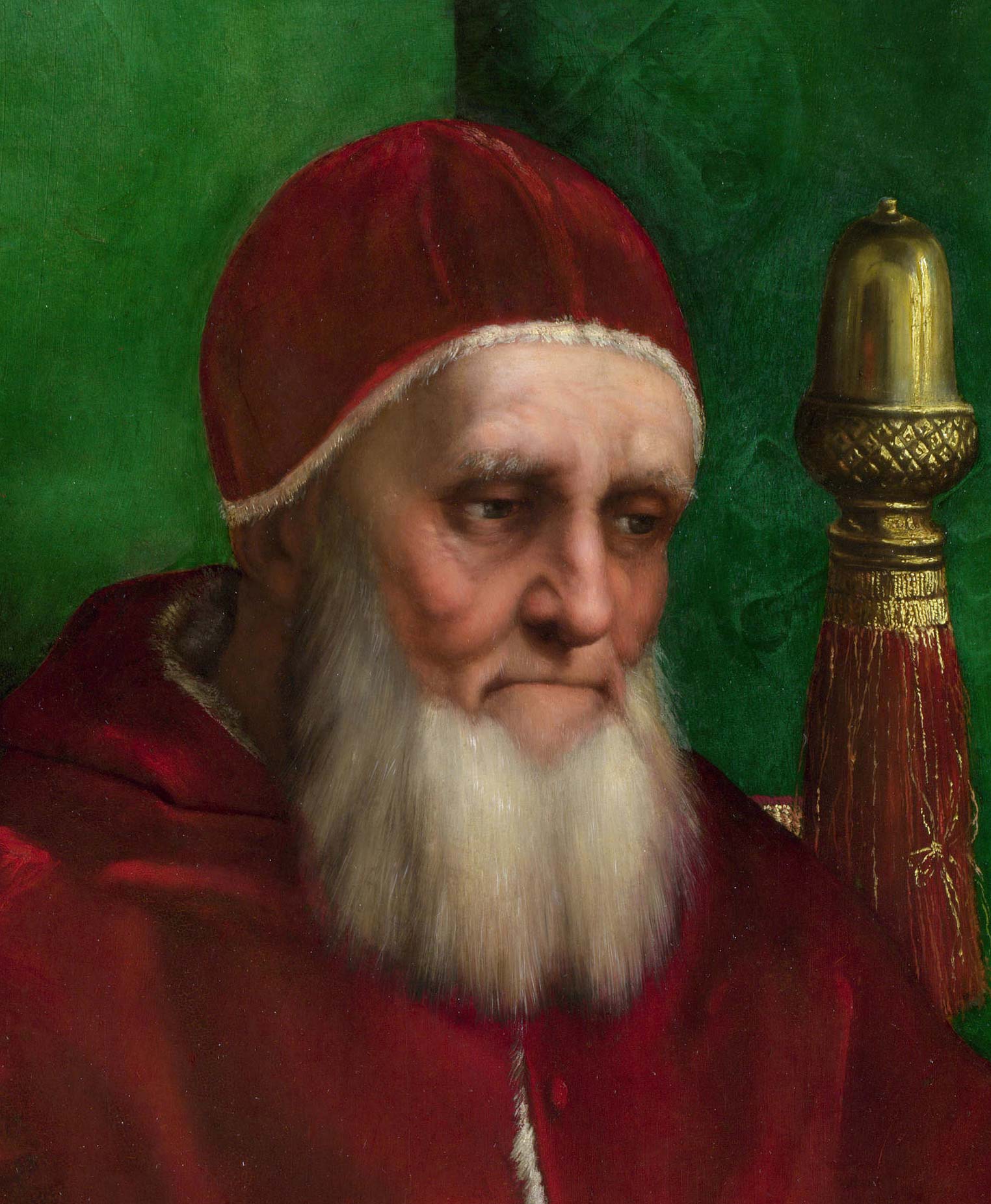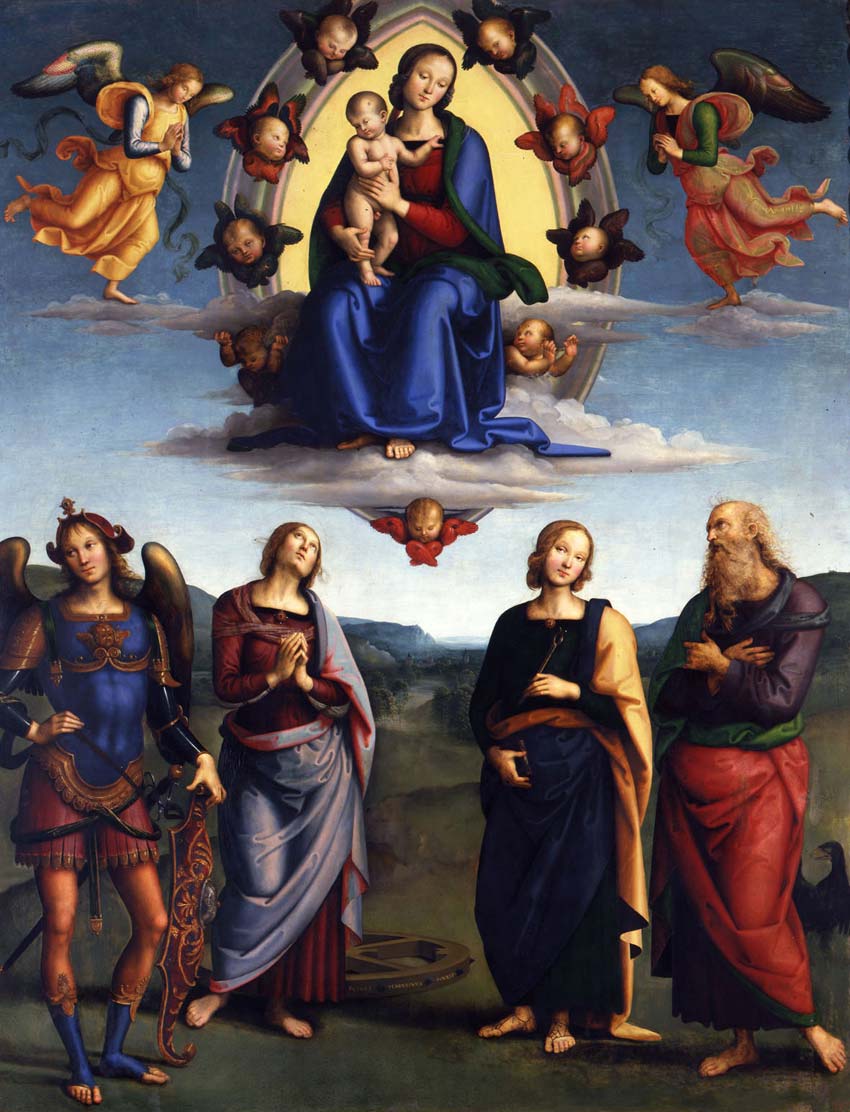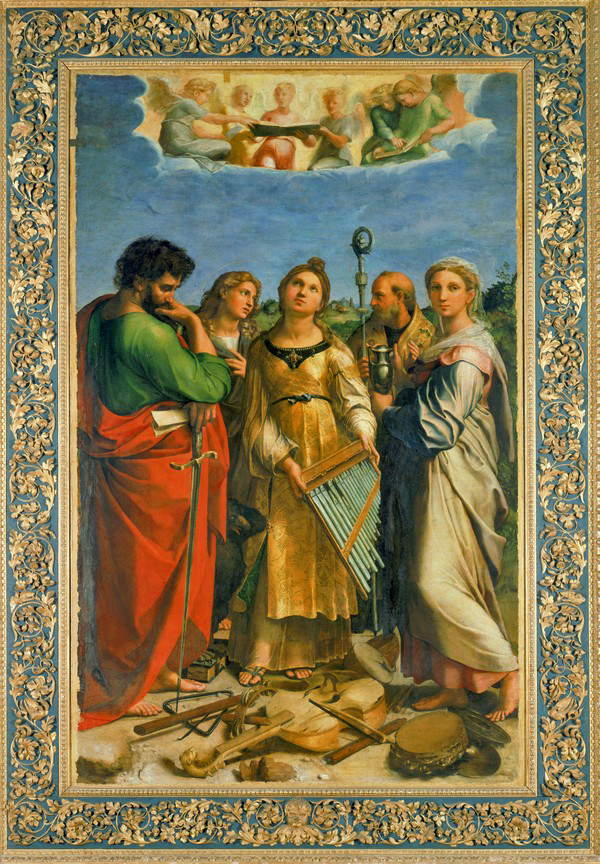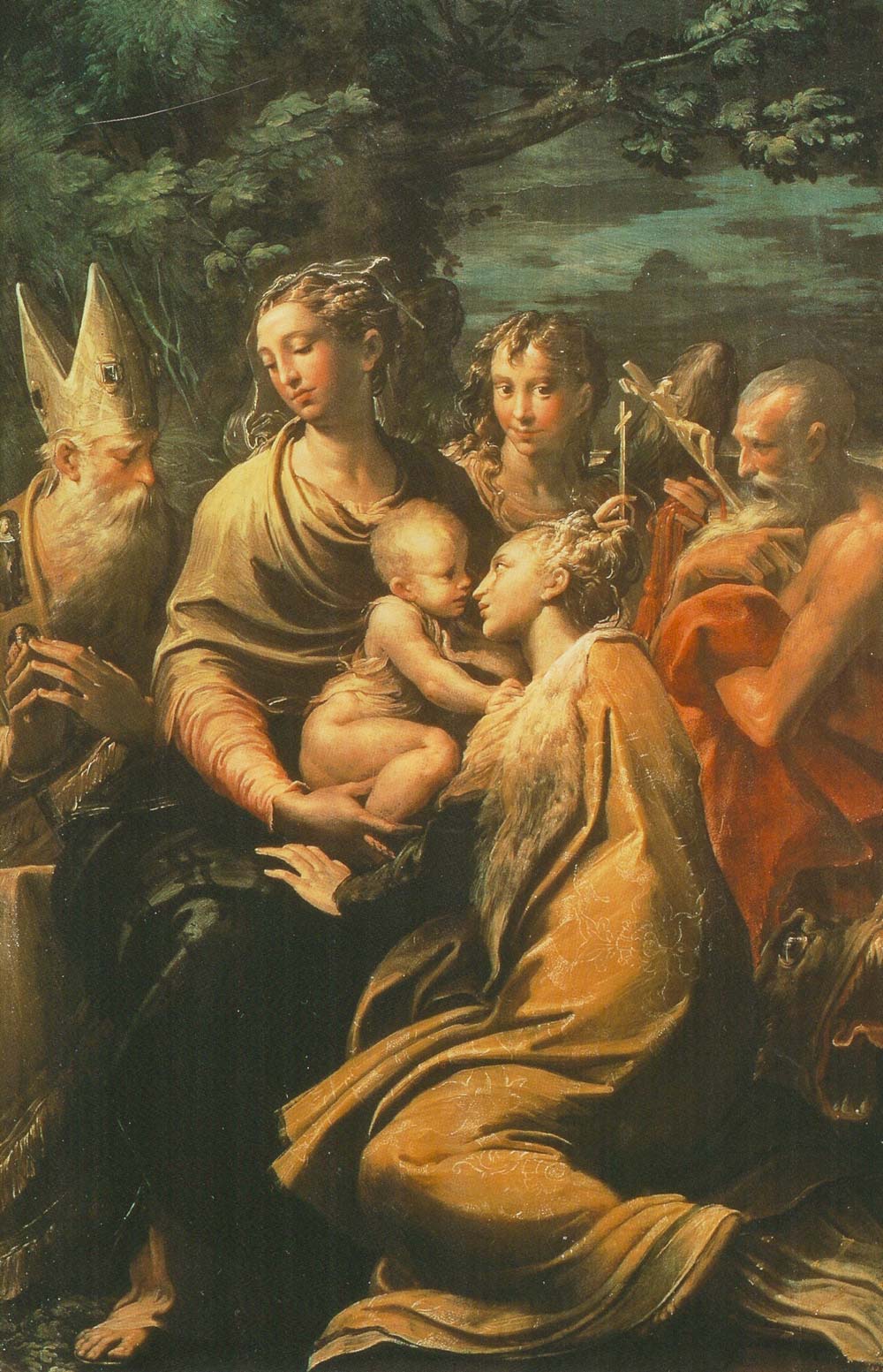The Pinacoteca Nazionale di Bologna in its rich patrimony holds the historical-artistic axis of the City’s pulse, and lately it has opened up to luminous initiatives of extraordinary vitality in connection with important anniversaries or events capable of certainly attracting all public interest. Credit goes to Director Maria Luisa Pacelli and the excellent scholars she wisely involves at every foreseeable milestone.
Today is of the highest cry the passage, which we would say triumphant, of the Portrait of Julius II executed by Raphael at the ascendant moment of his dazzling career (1512) when the Pope-King (as is really the case) had already delivered to him the Rooms of the Apostolic Palace so that through his frescoes make them the very paradigm of the truths of the Faith, of the journey that humanity must make in the transit to the infinite, and of the irreplaceable guidance of the Roman Pontiff at the prow of Peter’s ship.

The event of having in Bologna such a rare autograph for its subject and executive strength is due to the Pinacoteca’s relationship with the National Gallery in London and the previous exchange with the altarpiece of theEcstasy of Saint Cecilia, which the Urbino master had executed between 1515 and 1516 at the request of the Bolognese noblewoman later Blessed Elena Duglioli, for a chapel in San Giovanni in Monte. This altarpiece, preserved in the Pinacoteca Nazionale, constitutes the demonstrative fulcrum of the full Renaissance in Emilia, and today (alongside the portrait of Julius II) admirably serves to make the presence in the exhibition of the divine Raphael Sanzio blaze. The treasure trove of reading offered by the Heavenly Ecstasy of Saint Cecilia should not be lost during a visit to the Renaissance wing of the Gallery, where the exhibition is rightly housed, but traced back to the painter’s very close and pointed engagement over a fully human subject, equally dense with anagogic implications.
We must then address the “London” portrait in its function and contentions. Thanks to Raphael’s genius we are physically confronted with Giuliano, the tough prelate of the Savona Della Rovere family (1443-1513) who had first struggled against his modest origin, and then, made cardinal by his uncle Sixtus IV (1471), became involved in a thousand political, ecclesiastical, and military intrigues between Italy and France. He spent, among other things, the years from 1483 to 1502 as titular bishop of Bologna, but at the same time in Rome he became an opponent of the behavior of Alexander VI (Borgia pope) until he himself (after Innocent VIII and Pius III, his creations) was elected pope under the name of Julius II. He held the papacy for ten years (1503-1513) without ever neglecting all the earthly interests that had always surrounded him. Militarily in 1506 he had reconquered Bologna from the Bentivoglio seigniory, and here he had called in none other than Michelangelo to be molded into a superb bronze figure of a benedictory, which would later be destroyed. In the city, moreover, the pontiff had also called Bramante for certain architecture that was not fully followed up. Previously (1494) Buonarroti had made three small but scotent marble statues here in Bologna in the Arca di San Domenico: the San Pròcolo, theAngelo reggicero, and the San Petronio with the dedicatio urbis. These are works absolutely not to be forgotten when visiting the “new season of the Renaissance in Bologna” as the title of this exhibition so aptly puts it.
The iconographic confrontation with Raphael’s Julius II forces us into a close dialogue with the personage who, above his own tormented experience of facts and misdeeds, decided with unfailing will that the papal Urbe, the city on the Tiber, should once again become the capital of the world, as magnificent and solemn as ancient imperial Rome. Julius asked the utmost of the three Geniuses whom fate provided for him. To Bramante he had Bramante begin the new St. Peter’s, of unparalleled grandeur and majesty. From Michelangelo he obtained the superhuman frescoing of the vault of the Sistine Chapel and the imperishable marbles that were to bear witness to his tomb: the eternal Moses, and the cyclopean “Prisons” that lancinatingly confront the oppression of matter. To Raphael he entrusted the wall cycle of the famous Stanze, as already mentioned, where Sanzio’s meditation, ingenuity, and mensural and figural genius compose the ineffable balance of the one truth, human and divine, which brings Man as the masterpiece and protagonist of creation to the center: all this indicated by the mirandus juvenis who in his white robe looks down on us from the School of Athens.

The most factual reading of the Portrait of Julius II can begin with the very measurements (108 x 81 cm), unusual in the Italian tradition, which Raphael chooses as appropriate for a palatial portrait, that is, to be kept on display in a reception room, and in any case full historical witness to the protagonist. The painter himself would confirm and expand this meter and role in the portrait of his successor Leo X with two cardinals (1519). Correggio (1520) will also grasp this choice of great measure in the stupendous Portrait of Veronica Gàmbara, now in the Hermitage. Raphael’s desire is to give us the almost real presence of the pontiff: an unforgettable contact with him, whose body is brought very close to the “visual picture,” so much so that the cut tightens the figure and excludes the lower parts. This maneuvering of approach is accentuated by the pontiff’s diagonal posture and gives the immediate sensation almost of an accommodation just made toward the visitor; contributing to this are those hands stretched forward and moved in a loose, casual, and most spontaneous manner. A portrait with hands then, as Leonardo intended, and from the very few elements of appeal: among these are the golden acorns of the rear uprights of the simple seat that signal the Pontiff’s lineage but compositionally frame his face in a peremptory way. Here is the truthful portrait of the terrible pope who wears a slight camauro on his head: his face appears constricted between the headdress and beard so that his features and expression fully stand out and make him (as Raphael intended) the absolute point of the image. And it is the protagonist’s thought, all concentrated in a moment of meditation, that poses the excavation for us to intuit, to grasp what ferments in the mind of this man of such great power. The painter’s undoubted merit is that he has omitted all pontifical insignia and other attributes of census (the throne, the triregnum, the vestments) to give us a true and rude person in charge of history appeased in a silent cogitation, but perhaps bent on acts of sure value, here virtually entrusted to the prehensile energy of the left hand with the unstable “loquela digitorum.” An unforgettable portrait of thought.
In this vibrant panel we find a decidedly reduced chromatic choice: the impressive and total executional care, typical of Raphael, here does not indulge in the arpeggiating colorful chords of so many of his famous works but forces the seated pontiff onto only three dominant pigments: the red of the mozzetta and camauro, the white of the rocchetto, and the darkly copper-plated green of the background. A memorable pictorial “impromptu” that brings to life and sustains the flesh tones and golds.

The exhibition expands into a joyous adventure that embraces, as the title says, the Renaissance in Bologna. The city of Bologna was always a privileged meeting place of the arts as the centuries of the Middle Ages and its vibrant 15th century in particular show. In the transition to the early sixteenth century parade (if we may say so) with their colorful creations the great masters of Ferrara: Francesco del Cossa and Ercole de’ Roberti in the first place; then with their panels housed in the Gallery here sing their soothing melodies the admirable Bolognese Francesco Francia and Lorenzo Costa; the great arrivals of Perugino, Garofalo, Filippino Lippi, and even Cima da Conegliano. These are answered by the counterchants of the restless Aspertini, always dialectical and attractive, but also energetic and monumental. Here is the “new Bologna” that deserves to be rediscovered as the pulsing center of the Renaissance. The exhibition pours out a surprising preparation for the arrival of Raphael: a court of artists who had already characterized the advancing era of the “modern manner.”



In 1513 the altarpiece with The Ecstasy of St. Cecilia arrived in the city as a blazing sun, an autograph of supreme commitment by Raphael, a witness to the accomplished achievement of the new humanistic-theological eloquence, based on a pictorial technique of the highest caliber, on a multiple and prehensile composition, and on that involvement of celestial animosity that touches the soul of the believing admirer. Its execution follows shortly after the Portrait of Julius II and demonstrates the interpretive breadth of Sanzio, always deeply committed to different subjects. The altarpiece was destined in San Giovanni in Monte for the chapel of Blessed Elena Duglioli, a citizen of Bologna who had exemplified her own virtuous living on the figure of the martyr Cecilia. The painting played a decisive role on 16th-century Bolognese classicism from then on.
The undisputed pinnacle of Raphael’s presence, offering admirable fulfillment and ecstatic participation, was followed in the Bolognese painting world by the works of estimable artists, fatally involved as animated followers of the master’s canticle. Among them, the exhibition displays several great works by the excellent Innocenzo da Imola, Francesco Zaganelli, Girolamo Marchesi da Cotignola; and again Girolamo da Ferrara (known as “da Carpi”), Sebastiano Serlio and Girolamo da Treviso; and even the renegade Amico Aspertini, saporously bound to his own strong individualism. The cultural horizon thus opens toward the important sixteenth-century Bolognese workshops and toward the reception of now national stimuli: a most appreciable exhibition merit.



The moment of problematic sacredness, yet marked by sublime beauty, is offered almost at the end of the exhibition by the two panels by Francesco Mazzola, known as Parmigianino: the first the Madonna and Child with Saints executed in Bologna where the artist stayed for three years while fleeing the sack of Rome, from 1527 until 1530. The young and brilliant painter from Parma had taken to Rome and was considered the Raphael redivivivus, but he had existentially a less than benign fate. In Bologna he found some peace and much work, both as an engraver and as a painter: the San Rocco and the Donor in the basilica of San Petronio, along with the very famous altarpiece mentioned above, are to be admired by him in the city. Here “a new formal universe of sensitivity, elegance and grace” receives every acclamation for the very high level of quality. Same judgment for the unforgettable Madonna di San Zaccaria probably completed in Parma but commissioned in Bologna. Since Parmigianino carried, albeit in his own precipitous style, Correggio’s hometown airs, it will not be useless to recall that the Renaissance in Bologna would experience another exciting arrival: the Noli me tangere by Correggio between 1523 and 1524 in the Palazzo dei Conti Hercolani. Perhaps this masterpiece, which closely induces the subsequent immense spread of the Emilian School, will come to Bologna next year.
A historical drawing by Biagio Pupini closes the exhibition with the stigma of Charles V’s coronation in Bologna as Holy Roman Emperor at the hands of Pope Clement VII, signifying peace between the two crowns. At that time, the chosen venue consecrated the city of Bologna as the noblest capital of the Church State.
Today, the exceptional occasion opening towards myriads of visitors has called to new commitments and perfect disclosure celebrated scholars and the city’s two great cultural forces in the field of art, namely the Alma Mater Studiorum and the Academy of Fine Arts. The dazzling Silvana catalog is a true cultural heritage and benefits from high contributions: the fresh and fundamental introduction by Maria Luisa Pacelli; the forged and powerful portrait of Julius II in Elena Rossoni’s explication; and the historical chapter by Massimo Rospocher. Regarding the studies on the works in the catalog here is the masterful and inexhaustible wisdom of Daniele Benati, accompanied by Mirella Cavalli, Giacomo Alberto Calogero, Giovanni Sassu and again Elena Rossoni. Excellent insights by Massimo Medica, Alberto Dimuccio and Elisabetta Polidori. Much appreciated was the collaboration on the Exhibition of “Studio ESSECI - Sergio Campagnolo,” and in particular Simone Raddi.
Warning: the translation into English of the original Italian article was created using automatic tools. We undertake to review all articles, but we do not guarantee the total absence of inaccuracies in the translation due to the program. You can find the original by clicking on the ITA button. If you find any mistake,please contact us.